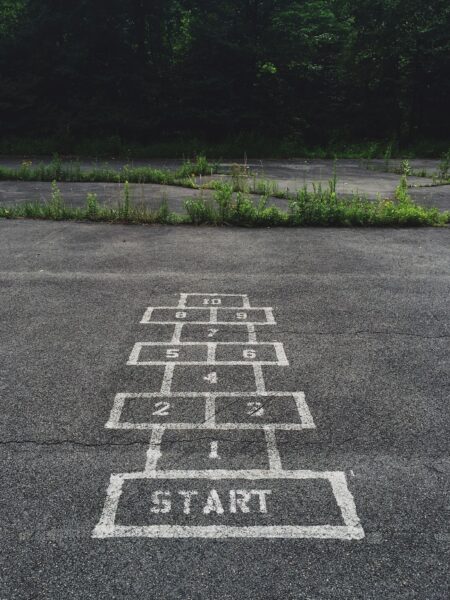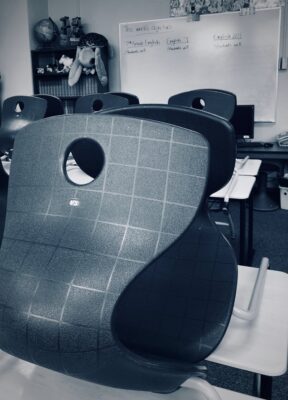My district was one of the first in our region to go back to school face-to face this year. We began a “hybrid model” on September 14, with seniors and K-3 going four days a week, and all others going twice-a-week in cohorts (Monday/Thursday and Tuesday/Friday). On Wednesdays we delivered online material and caught up with our work, while reinventing it simultaneously. Some of our students opted for full-time distance learning, but the vast majority excitedly prepared for the first day of school.
Our neighbor districts were watching us intently. Would we pave the way for others to follow us, or would we cause an outbreak in our tiny town?
One week in, “it” happened. A student, who later tested positive for Covid-19, attended the first day of school. Dozens of staff members and students were subsequently quarantined due to contact with the student, and the decision was made to suspend school until the 14-day quarantine period was over, giving the health department time to do all of the necessary contact tracing. Our schools and buses were disinfected, and our teaching staff pivoted to all online learning, something we were told was likely to happen from the start.
Not an auspicious beginning, you might say. But let me elaborate.
Category Archives: Current Affairs
Teaching is Political
Recently, as a response to widespread use of The 1619 Project, a New York Times Magazine feature exploring the often untold realities of America’s long history of policies and practices endorsing and even promoting enslaving fellow humans, President Trump announced the establishment of the 1776 Commission, a federal focus on “patriotic education” which, it seems, will not address the negative or troubling realities of our country’s past.

I am not afraid to show my bias against this commission. I’ve read some of the criticism of The 1619 Project. Some is valid, some is overwrought. None is sufficient to warrant our country’s ignoring of the fact of enslavement and the observable, measurable, identifiable historical ripple effect it had right up to this very second.
A good history (or literature) teacher will encourage students to interrogate what isn’t being said, whose side isn’t being shared, whose voice isn’t being elevated. What is absent is telling, always. What we choose not to teach is as political a choice as what we choose to teach. And to take it further, the deliberate omission of the truth is a much a lie as is the truth’s deliberate revision.
Continue readingI Taught a Lesson Today!
It’s Tuesday, September 22, 2020. School started on September 2. We are three weeks in.
Due to health concerns, I moved from my fifth-grade classroom at a brick-and-mortar school to teaching at our district’s online academy. I get up and dressed for work each day. Then I walk down the hall to the study or the dining room table or the card table in the family room.
Continue readingVirtual Teaching… from where?

As we ready ourselves to start a new school year unlike any other in our history, many districts in our state are once again embroiled in debates about teachers-as-workers and the rights and protections we deserve.
A sticking point in many places strikes me as fundamentally confusing: Whether instructional staff should conduct distance learning or virtual teaching from their physical classrooms or whether they should be permitted the flexibility to do so from off site.
I gotta be honest: This feels like a no-brainer. If students are learning remotely, why should teachers not have the flexibility to do their work from the environment they feel is best for their and their family’s health and safety? Personally, I have decided that I will probably be heading into my classroom unless I’m told I cannot. My preference, though, isn’t shared by others. And those others have valid reasons for not wanting to leave the relative safety of their homes…and even if we as a society seem to have forgotten that we are in the midst of a global pandemic, my colleagues’ valid concerns are literally matters of life-or-death.
My biggest problems with the debate have to do with the reasons being given as to why teachers should report to their classrooms for virtual teaching. None of these reasons, to me, outweigh the personal health and safety of a teacher or a teacher’s family: If our work can be done effectively from a safe environment, why not? (Sadly, local news sources like to stir the pot on this issue, with at least three local outlets in the Portland/Vancouver area doing the old “hey viewer, what do YOU think?” about where and how I and my colleagues ought to do our jobs.) From district leaders, policymakers, parents and the public, I’ve noticed four common arguments for requiring teachers to teach virtually from an empty classroom:
Common Reason #1 for Requiring Teachers to Report to School for Virtual Teaching: The employer has the right to verify that the work they are paying teachers to do is actually getting done. Okay, on the surface, I don’t disagree. How did this happen in face-to-face learning? Admin drop-ins and observations? Stacks of student work or student art on the walls? Student and parent feedback? These, or something analogous, can and will happen in a virtual setting. In fact, a virtual setting inherently creates mountains more potential artifacts that a teacher is “putting in the work.” From last spring, I have hours and hours of videos, mountains of virtual folders of work still in my Google Drive, and electronic data trails far more enduring than much of what was produced by my face-to-face teaching (where there would be whole class periods that might go by filled with interactions, discussions, probing questions, and coaching conversations: none of which necessarily produce any immediately tangible evidence that these ever even happened).
Common Reason #2 is closely related: Last spring there were many teachers working triple duty to do their job well, while others for whatever reason (lack of skill or lack of will) skated by doing much less. In theory, getting every teacher in the building will help with that, since supposedly the administration will have nothing else to do but diligently oversee everyone’s work (sarcasm). This is a classic case of creating policy for all in order to attempt to force the fringes toward different behavior. This is also, however, exceptionally poor leadership. Are there teachers not doing as much as they should? Such a population exists in every profession and also existed in teaching before the world flipped upside down. Rather than create policy that constricts the many, it makes more sense to exert instructional and managerial leadership to remediate the few. Just as it is a disservice to my ready learners for me to engage in sweeping classroom micromanagement to forcibly compel compliance from reluctant learners, it makes no sense to adopt blanket personnel policy for all when what really needs to happen are tough, uncomfortable supervisory conversations with the few who may be shirking their responsibilities.
Common Reason #3: It will make the transition to eventual hybrid or face to face learning easier. Okay: How? I’ve yet to hear a convincing follow-up answer to this. I am concerned about how I can facilitate my students’ eventual transition, but I can handle relocating my own work if needed. The small number of teachers who can’t handle that? Again, like above, that’s a small group and is a management/supervisory issue.
Common Reason #4, the least persuasive: It is bad optics to have teachers working from home. I get that we are public schools. I also understand that the public will have strong opinions about anything and everything teachers do. But again: How many people are we really talking about? No matter what teachers do, ever, there will always be a faction of the public outraged and ready to take it to the supe’s office. Now would be a great time for our leaders to smile and nod at those complainers, and then consider policy that serves the physical and mental health of the employees…those same employees being charged with scaffolding up the physical and mental health of our students. (It is perpetually disheartening to see, nationwide, school systems that refuse to treat employees with the same essential care and humanity they expect those employees to provide for students.)
As the s-word starts to bubble up for various reasons in school districts across the nation, when it comes to where we teach virtually from it feels like we (labor) are fighting a fight we should not have to. Has anyone out there heard valid, compelling reasons why teachers should not have the flexibility to teach from wherever they feel safest during distance learning? Despite what it might seem from this screed, I’m open to having my mind changed.
August: Four Things I Need to Remember

Normally, I could move through August a little bit on auto-pilot: get the room set up, check the rosters, re-tool and update the curriculum, plan to fold in the lessons learned from the previous year, maybe build a new unit or two based on my most recent reading or learning.
Like many schools in Washington, my district is starting up in September fully virtual/distance learning, a difficult decision and one I personally support both as an educator and as a parent. For that reason, auto-pilot is a no-go. This is hands-on navigation through a hurricane. In a mountain range. At night. With no GPS and glitchy radar. And there are murder hornets in the cockpit.
I cannot plan in a vacuum: the pandemic, the protests, the politics, these are all realities that I understand will impact what I do as the outside world pushes into my classroom unlike ever before. This August, I’m focusing on a few things I need to remember as I welcome students, virtually, into our learning environment:
Real Student Conversation

I started last Wednesday’s zoom office hours assuming that my students would most likely ask questions around their statistics math work. I spent the earlier part of the week predicting which questions they may have complications with, creating problems with step-by-step explanation, and jotting down my calendar availability in case students needed extra support sessions.
I start all zoom meetings asking my attendees how their weekend was. Delightful conversation usually occurs around how we are all keeping busy while staying at home. Once all the students have had an opportunity to share, we switch topics and discuss math. This last Wednesday was NOT business as usual.
My first student asked, “Mrs. Eaton, did you hear there is going to be a protest down at Winco?”
I said, “Yes, I heard about that.”
The discussion quickly unfolded into a slew of questions. Math wasn’t spoken of at all during the day’s sessions.
Some of my students are very confused and scared about what is happening in our country. There were varying opinions on what students have been seeing on TikTok. It was interesting to discover that students receive much of their news from TikTok, the social media platform where people are sharing funny dance moves, challenges, and jokes.
Students discussed different TikToks they had seen and how they were affected. I asked students to think about the accuracy/validity of what they were viewing. Students defended TikTok and expressed they felt it was “unfiltered real news”. When I asked them what they meant by that, they unanimously replied that you can’t trust news from the television.
The conversation then switched to racism. Some of my students vocalized they wanted to demonstrate their support while under quarantine (still in phase 1 where we live.) Others were scared because undocumented older siblings were going to attend the protest. They feared the police would catch them and send them to a detention facility.
Many of my citizen students never considered that some of their classmates were not documented. An eerie silence filled the zoom room when a student asked another if they were born here. I interjected and asked my students to think about whether it is okay to discriminate against anyone on the basis of race, sexual orientation, gender, religion, or national origin?
I can’t help but wonder what this would have looked like in a regular classroom. Would students have been shy to speak up? Does the stop video function act as a courage button in allowing students to be more vocal? Does the chat function facilitate hearing the voices of students who, in a regular classroom setting, would have been overshadowed by outspoken students?
During distance learning our priority, as educators, has been intensely focused on providing equitable instruction. I have been researching best practices, planning, and preparing what the start of 2020-2021 will look like. It is easy to forget, at times, that our classrooms were safe spaces where students were able to ask non-academic questions.
The best thing I could do was listen and allow an open forum for their discussion. The honest truth is that in today’s society, teachers are assumed to be viewed as neutral or as a moderator when discussing such topics with students. Students look up to their teachers and are influenced by our views, regardless of how we stand on any issue.
I understand that there are many ways to dismantle institutional racism and other controversial issues affecting our country. However, let’s not forget that space must be provided for students to question and discuss these issues in a non-threatening environment. It is through moments like this that understanding occurs, unconscious biases are discovered, bias starts to be extinguished, and our society begins to change for the better.
Roll Up, Roll Up!
For years I taught a 5/6 split. The students I had as fifth graders “graduated” into being sixth graders in my next year’s class. Half my class each year was made up of returning students; I called them my “vets.” Half my class was made up of incoming students; they were my “newbies.”
Now I teach a straight fifth grade.
Boy, I miss having a consistent roll up.
There are so many advantages to having a roll up or “looping” classroom.
ONE
When I taught in a roll up, I had every student for two years, increasing student-teacher connections. I saw more improvements. Kids who might be quiet the first year came out of their shell more the second year. They blossomed! They went from not wanting to answer a question in class to clamoring for us to take our class poetry readings on the road.
I remember one third grader announcing to me on the last day of school, “I hate doing work!” I watched him run to the bus and thought, We’ll see how long that lasts. It actually lasted all of fourth grade, but by fifth grade he turned the corner. He became a diligent student, happy to put in the effort because he loved seeing all the great things he could accomplish.
I can make a big difference in a single year. In two years I can do magic.
TWO
Students hit the ground running.
You know how you spend a long time in the fall teaching your class the routines and protocols of your classroom?
With a roll up I could do that so much faster.

Distance Success

For the vast majority of my students, distance learning has not been working.
Not just my classes, but the concept in general. Many report that their lives outside of school are often unstructured, unfettered, tumultuous, so the routine and predictability (and accountability) of school was what kept their footing. They miss being greeted by the principal and our awesome secretaries every single morning. They miss our one-hallway community where literally everyone knows your name. They even miss my bad dad-jokes. (I added that last one, because I’m just assuming…)
They share with me that it isn’t the content, or the tasks, or the obscure grading expectations, or the fact that they might spend hours staring at a chromebook. It is the loss of the structure of school, both literal and figurative.
While some are adrift, a handful are experiencing an academic transformation. The numbers are small, but there is something about this distance learning thing that is working for them. Let’s take one student, who I’ll call B*. Prior to March 13th, attendance was spotty. When present, B was physically present only. Despite constant attempts to connect, few of us on staff were able to claim we actually had a sustained conversation with them. In the weeks prior to the shutdown, I received two assignments from B. They weren’t defiant, and to be honest their skills (in my classes, at least) did not appear to be deficient in any significant way. B was, and is, an enigma we are continuing to work to unravel.
Transition to distance learning and this same student had nearly the highest rate of engagement of all my students. This is a student listed as homeless, with a history of bouncing from school to school, and with a outside-of-school life that instantly led to worry every time they missed school. When I asked B why distance learning seemed to work, I parsed out three trends in their (short) reply:
Continue readingThen and Now
THEN
Almost everything I need to teach math or ELA or science or social studies or health is in my classroom. Student books. Math tests. ELA papers.
NOW
I sent some of the books home with the kids on that ill-fated Friday the 13th: math, science, and Roald Dahl’s autobiography Boy. Per instructions, I sent home papers for six weeks’ worth of work.
The work I sent home immediately became “optional” once we learned that we could not require or grade any work sent home. Then, a couple of weeks later, we learned we could start instruction again.
The additional books and papers I want to use with my students for the rest of the year are in my classroom. There is no way to get them to my students now.
I have to check for coronavirus-era copyright access for materials for my students. For some of the materials, I have to scan (once I get permission) stacks of pages and email them to families. (At least I have the stuff at home!) I have to search the web for open-source materials.
THEN
I think of teaching as a performance art. I make eye contact with my kids as I teach. I respond to their body language, their facial expressions.
I walk around the room, monitoring multiple small groups. I manage behaviors quietly, usually with humor.
Continue readingThis Is Heavy: The WATAC Conference and Finding Meaning
Last weekend I attended the 4th Annual Washington Teacher Advisory Council’s Spring Conference. The planners re-organized their conference into an online format. Amazingly, they were able to accommodate the largest number of attendees in their history thus far. That is one positive when it comes to the distance learning format. We can fit more folks into the “room.”
Don’t get me wrong; I would have much preferred seeing all my friends and colleagues from around the state in person. I look forward to it every year. However, seeing them all virtually and hearing how they are dealing with our unprecedented issues these last months of the school year was invaluable.
If you are unfamiliar with WATAC, it is an organization formed initially to organize award-winning teachers in our state to make our expertise available to stakeholders with influence on education policy. Since its inception, it has expanded to include leaders from all aspects of education – administration, certificated, and classified. Anyone with an interest in teacher leadership is welcome at the conference. And, for me, the conference has been a great way to get a shot of teacher energy as the final stretch of the school year hits, and I really, really need that boost.
This year…I really needed a boost.

Don’t we all? The truth is I am actually grieving. I wobble back and forth between shock, depression, and a sort of manic activity level of problem solving. I’m a mess! In fact, the concept of the five stages of grief won’t get out of my head. Although, losing a loved one is unspeakably worse, losing my classroom feels like a huge loss. After all, I love my job. I love the most annoying of my seventh graders and the snarkiest of my seniors. I am deeply attached to my classroom, my kids, and my teacher lifestyle. So, yes, I am grieving the loss.
The five stages are trademarked, actually. You can go to David Kessler’s website, if you are interested in what he says about grief and grieving. After wondering if I was actually experiencing grief, I looked over the process: denial, anger, bargaining, depression, and acceptance.
Yep. I’m doing all of that.
The conference theme was “Back to the Future, and keynote speaker Amy Campbell, our current Washington State Teacher of the Year, quoted the famous meme that comes from the movie Back to the Future, the one where Marty McFly says, “This is heavy.”
This IS heavy, Marty. You thought it was tough that your mom had a crush on you. But this, THIS is heavy.
Education is changing. This is not merely a moment of pause. We can’t go back to normal. In this crisis we have pulled back a curtain and revealed serious problems with equity in education. Yes, we knew they were there, but it is easy to just go about our business making little shifts that don’t rock the boat too much.
It won’t work that way this time. Serious change is needed, and now is exactly the time to work on it.
As Amy told us- speaking directly to my teacher soul – we are experiencing loss. We are in a crisis that impacts our safety, our economy, and our mental health. “Hindsight really is 2020,” and we need to find our “place on the continuum and start moving forward.”
Most importantly, she said, “Old normal should not be the final destination.” And I feel that. I really do.
As a member of the teacher panel later in the conference, I was asked what was working, what was hard, and what I want to take into the future of education. I don’t remember what I said exactly, and I hope it made some sense at the time. But, I can summarize right now.
What’s working? YouTube, Padlet, Zoom, and all the technology no one thought we could use on such a large scale.
What’s hard? Missing the kids and noticing that some fell off the radar when the crisis hit. Many of my kids live in crisis all the time. Not knowing where they are right now is indescribably tough..
What to take forward? Poor kids, rural kids, isolated kids—they deserve whatever the other kids get. I don’t want to see how the one-to-one schools gracefully flipped their systems to accommodate distance learning. I want to see how internet access becomes a universal right for all families. I want legitimate supports for English language learners and students with IEPs and 504 plans. I want to see every teacher receiving the training to support distance learning. I want my tiny district to have more than the grit, goodwill, and volunteer spirit that is filling the gaps in the system. I want equity for all- educators, families, students, all of us.
That’s what I would take to the future.
So, thank you Amy and all the other wonderful WATAC planners and facilitators. You acknowledged what we are going through and you set us on an impassioned path to the future. You did not pretend it was easy, but you did assure us that we are not alone on this journey. There are a lot of amazing educators who are fighting the fight alongside us. So thank you.
In closing, my grief research led me to David Kessler’s final stage of grief from his latest book. He calls it “finding meaning.” It is the way that we can begin to move forward. We find meaning in the loss. I am starting to feel like I am on that path. With the “loss” of my familiar job as an educator, I am focusing on how to reinvent it to make it equitable, relevant, engaging, and, well, comforting, for the students of my future classroom, online or elsewhere. I am beginning to plan going back to the future.
Amy’s Keynote on OSPI’s YouTube Channel